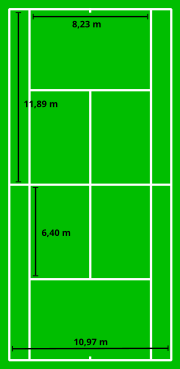Tennis is played on a rectangular, flat surface, usually grass, clay, or a hardcourt of concrete and/or asphalt. The court is 78 feet (23.77 m) long, and its width is 27 feet (8.23 m) for singles matches and 36 ft (10.97 m) for doubles matches.Additional clear space around the court is required in order for players to reach overrun balls. A net is stretched across the full width of the court, parallel with the baselines, dividing it into two equal ends. The net is 3 feet 6 inches (1.07 m) high at the posts and 3 feet (91.4 cm) high in the center.
The modern tennis court owes its design to Major Walter Clopton Wingfield who, in 1873, patented a court much the same as the current one for his stické tennis (sphairistike). This template was modified in 1875 to the court design that exists today, with markings similar to Wingfield's version, but with the hourglass shape of his court changed to a rectangle.
Lines
The lines that delineate the width of the court are called the baseline (farthest back) and the service line (middle of the court). The short mark in the center of each baseline is referred to as either the hash mark or the center mark. The outermost lines that make up the length are called the doubles sidelines. These are the boundaries used when doubles is being played. The lines to the inside of the doubles sidelines are the singles sidelines and are used as boundaries in singles play. The area between a doubles sideline and the nearest singles sideline is called the doubles alley, which is considered playable in doubles play. The line that runs across the center of a player's side of the court is called the service line because the serve must be delivered into the area between the service line and the net on the receiving side. Despite its name, this is not where a player legally stands when making a serve.The line dividing the service line in two is called the center line or center service line. The boxes this center line creates are called the service boxes; depending on a player's position, he will have to hit the ball into one of these when serving.A ball is out only if none of it has hit the line upon its first bounce. All the lines are required to be between 1 and 2 inches (51 mm) in width. The baseline can be up to 4 inches (100 mm) wide if so desired.
Play of a single point
The players (or teams) start on opposite sides of the net. One player is designated the server, and the opposing player, or in doubles one of the opposing players, is the receiver. Service alternates between the two halves of the court. For each point, the server starts behind his baseline, between the center mark and the sideline. The receiver may start anywhere on their side of the net. When the receiver is ready, the server will , although the receiver must play to the pace of the server.
In a legal service, the ball travels over the net (without touching it) and into the diagonally opposite service box. If the ball hits the net but lands in the service box, this is a let or net service, which is void, and the server gets to retake that serve. The player can serve any number of let services in a point and they are always treated as voids and not as faults. A fault is a serve that is long, wide, or not over the net. There is also a "foot fault", which occurs when a player's foot touches the baseline or an extension of the center mark before the ball is hit. If the second service is also faulty, this is a double fault, and the receiver wins the point. However, if the serve is in, it is considered a legal service.
A legal service starts a rally, in which the players alternate hitting the ball across the net. A legal return consists of the player or team hitting the ball exactly once before it has bounced twice or hit any fixtures except the net, provided that it still falls in the server's court. The ball then travels back over the net and bounces in the court on the opposite side. The first player or team to fail to make a legal return loses the point.
Scoring
A tennis match is composed of a number of sets. Typically for both men's and women's matches, the first player to win two sets wins the match. At certain important tennis tournaments for men, including all four Grand Slam tournaments and the final of the Olympic Games, the first man to win three sets wins the match. A set consists of games, and games, in turn, consist of points.
A game consists of a sequence of points played with the same player serving. A game is won by the first player to have won at least four points in total and at least two points more than the opponent. The running score of each game is described in a manner particular to tennis: scores of zero to three points are described as "love" (or zero), "fifteen", "thirty", and "forty" respectively. (See the main article Tennis score for the origin of these words as used in tennis.) If at least three points have been scored by each player, and the scores are equal, the score is "deuce". If at least three points have been scored by each side and a player has one more point than his opponent, the score of the game is "advantage" for the player in the lead. During informal games, "advantage" can also be called "ad in" or "ad out", depending on whether the serving player or receiving player is ahead, respectively.
In tournament play, the chair umpire calls the point count (e.g., "fifteen-love") after each point. The score of a tennis match during play is always read with the serving player's score first. After a match, the score is always read with the winning player's score first. At the end of a game, the chair umpire also announces the winner of the game and the overall score.
A game point occurs in tennis whenever the player who is in the lead in the game needs only one more point to win the game. The terminology is extended to sets (set point), matches (match point), and even championships (championship point). For example, if the player who is serving has a score of 40-love, the player has a triple game point (triple set point, etc.) as the player has three consecutive chances to win the game. Game points, set points, and match points are not part of official scoring and are not announced by the chair umpire in tournament play.
A break point occurs if the receiver, not the server, has a game point. Break points are of particular importance in men's professional tennis because serving is generally advantageous. The advantage to the server is much less in the women's game.[citation needed] A receiver who has two (score of 15-40) or three (score of love-40) consecutive chances to win the game has double break point or triple break point, respectively. As with game, set, and match points, break points are not announced.
A set consists of a sequence of games played with service alternating between games, ending when the count of games won meets certain criteria. Typically, a player wins a set by winning at least six games and at least two games more than the opponent. If one player has won six games and the opponent five, an additional game is played. If the leading player wins that game, the player wins the set 7–5. If the trailing player wins the game, a tiebreaker is played. A tiebreaker, played under a separate set of rules, allows one player to win one more game and thus the set, to give a final set score of 7–6. Only in the final sets of matches at the Australian Open, the French Open, Wimbledon, the Olympic Games, Davis Cup, and Fed Cup are tiebreakers not played. In these cases, sets are played indefinitely until one player has a two game lead. A "love" set means that the loser of the set won zero games. In tournament play, the chair umpire announces the winner of the set and the overall score.
In tournament play, the chair umpire announces the end of the match with the well-known phrase "Game, set, match" followed by the winning person's or team's name.
Rules variations
| Name | Description |
|---|---|
| No-ad | The first player or doubles team to win four points wins the game, regardless of whether the player or team is ahead by two points. When the game score reaches three points each, the receiver chooses which side of the court (advantage court or deuce court) the service is to be delivered on the seventh and game-deciding point. |
| Pro set | Instead of playing multiple sets, players may play one "pro set". A pro set is first to 8 (or 10) games by a margin of two games, instead of first to 6 games. A 12-point tiebreaker is usually played when the score is 8-8 (or 10-10). These are often played with no-ad scoring. |
| Match tiebreak | This is sometimes played instead of a third set. This is played like a regular tiebreak, but the winner must win ten points instead of seven. Match tiebreaks are used in the Hopman Cup for mixed doubles, on the ATP and WTA tours for doubles and as a player's choice in USTA league play. |
Another, however informal, tennis format is called "Kiwi doubles", "Canadian doubles" or "cut-throat".This involves three players, with one person playing a doubles team. The single player gets to utilize the alleys normally reserved only for a doubles team. Conversely, the doubles team does not use the alleys when executing a shot. The scoring is the same as a regular game. This format is not sanctioned by any official body.
"Australian doubles", another informal and unsanctioned form of tennis, is played with similar rules to the "Kiwi" style, only in this version, players rotate court position after each game. As such, each player plays doubles and singles over the course of a match, with the singles player always serving. Scoring styles vary, but one popular method is to assign a value of 2 points to each game, with the server taking both points if he or she holds serve and the doubles team each taking one if they break serve.
Wheelchair tennis can be played by able-bodied players as well as people who require a wheelchair for mobility. An extra bounce is permitted. This rule makes it possible to have mixed wheelchair and able-bodied matches. It is possible for a doubles team to consist of a wheelchair player and an able-bodied player (referred to as "one-up, one-down"), or for a wheelchair player to play against an able-bodied player. In such cases, the extra bounce is permitted for the wheelchair users only.















No comments:
Post a Comment